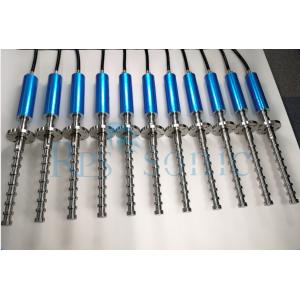

Add to Cart
Introduction:
Parameter
The core content of ultrasonic nanotechnology is how to solve the
problem of agglomeration of nanoparticles. Since the nanoparticles
are easy to agglomerate, it is very difficult to obtain a single
dispersed nanoparticle. How to uniformly disperse the nanoparticles
into the matrix is the key technology of nanotechnology. . Our
series of ultrasonic products use the cavitation of ultrasonic
waves to disperse agglomerated particles. It puts the particle
suspension (liquid) to be processed into an ultra-strong sound
field and processes it with appropriate ultrasonic amplitude. Due
to the inherent characteristics of powder particle agglomeration,
for some powders that do not disperse well in the medium, an
appropriate amount of dispersant can be added to maintain a stable
dispersion state, which can generally reach tens of nanometers or
even smaller. This product is especially It has a good effect on
dispersing nanomaterials (such as carbon nanotubes, graphene,
silica, etc.).
Ultrasonic dispersion refers to the process of dispersing and
de-agglomerating particles in a liquid through the "cavitation"
effect of ultrasonic waves in the liquid using a liquid as a
medium.
As a physical means and tool, ultrasonic technology can produce
various extreme conditions in liquids. This phenomenon is called
sonochemical action, and the related ultrasonic equipment is called
ultrasonic sonochemical equipment (referred to as "acoustic
chemical equipment"). . Ultrasonic dispersion equipment is an
application of sonochemical equipment, which can be used for water
treatment, solid-liquid dispersion, particle agglomeration in
liquids, and promoting solid-liquid reactions.
The phenomenon of material migration spontaneously due to the
thermal movement of particles (atoms, molecules or groups of
molecules) is called "diffusion".
Diffusion can be performed in one phase of solid, liquid, and gas
in the same substance, or between different solids, liquids, and
gases. It is mainly caused by the difference in concentration or
temperature. Generally, it diffuses from the area with higher
concentration to the area with lower concentration, until the
concentration of each part in the phase reaches uniform or the
concentration between two phases reaches equilibrium. When
materials directly contact each other, they are said to be free to
diffuse. Diffusion is called permeation if it occurs through a
barrier.
Diffusion plays a big role in nature, and it keeps the atmosphere
around the entire surface of the earth the same composition. The
diffusion of various salt solutions contained in the soil is easy
for plants to absorb and facilitate growth. In addition, diffusion
is applied in many industries such as semiconductor and metallurgy.
Diffusion, heat conduction and viscosity are commonly referred to
as transport phenomena. It moves matter (mass), thermal energy, and
momentum from one position to the other. To achieve uniform
concentration or temperature.
Ultrasonic dispersion can be divided into emulsion dispersion
(liquid-liquid dispersion) and suspension dispersion (solid-liquid
dispersion), and has been applied in many fields. The application
of ultrasound to the dispersion of suspensions also includes:
dispersion of titanium oxide and the like in water or solvents in
the coating industry, dispersion of dyes in molten paraffin,
dispersion of drug particles in the pharmaceutical industry, and
powder emulsions in the food industry. Disperse etc.
Application:
• Cell disrupter (extraction of plant substances, disinfecting, enzyme deactivation)
• Therapeutic ultrasound, i.e. induction of thermolysis in tissues (cancer treatment)
• Decrease of reaction time and/or increase of yield
• Use of less forcing conditions e.g. lower reaction temperature
• Possible switching of reaction pathway
• Use of less or avoidance of phase transfer catalysts
• Degassing forces reactions with gaseous products
• Use of crude or technical reagents
• Activation of metals and solids
• Reduction of any induction period
• Enhancement of the reactivity of reagents or catalysts
• Generation of useful reactive species
